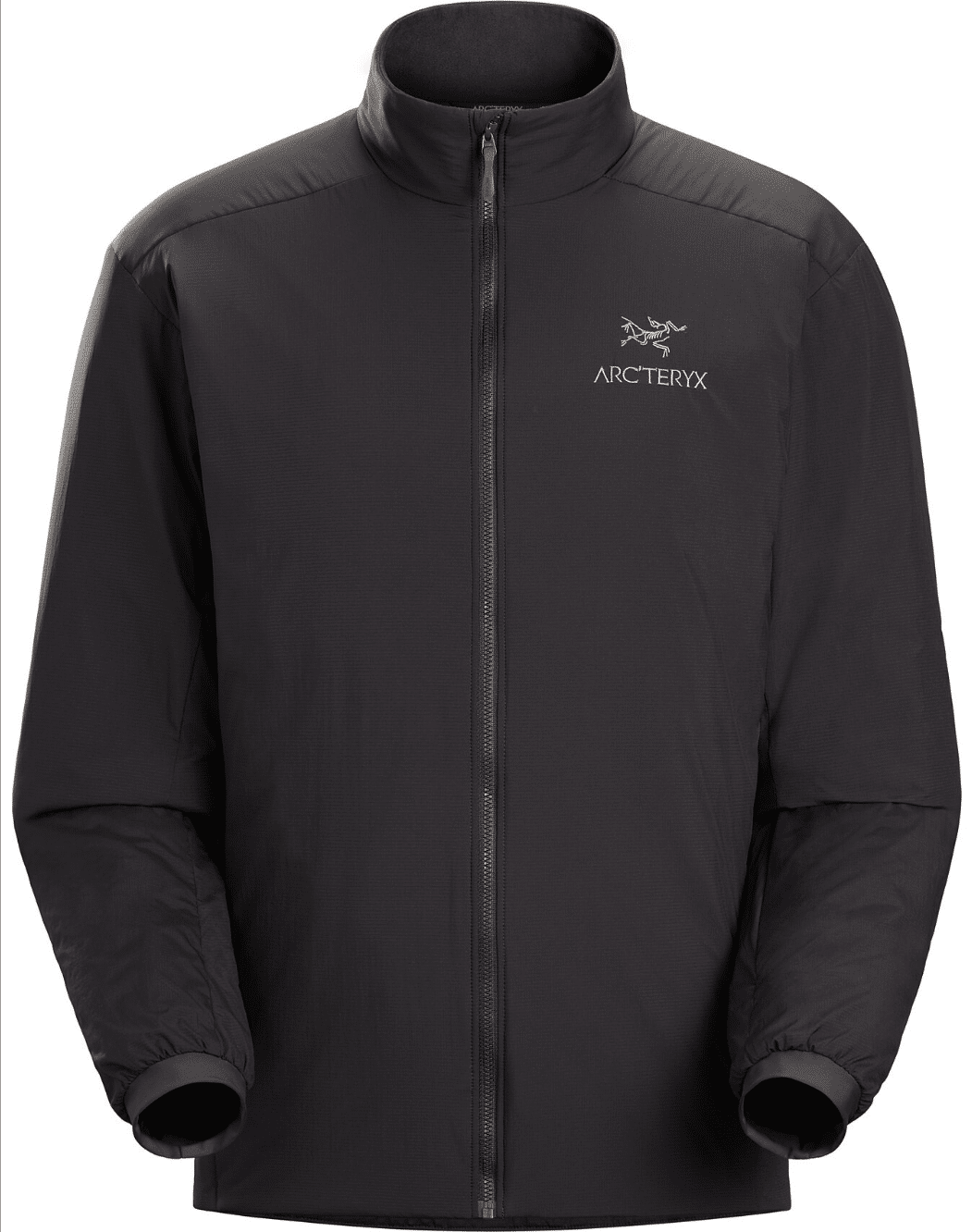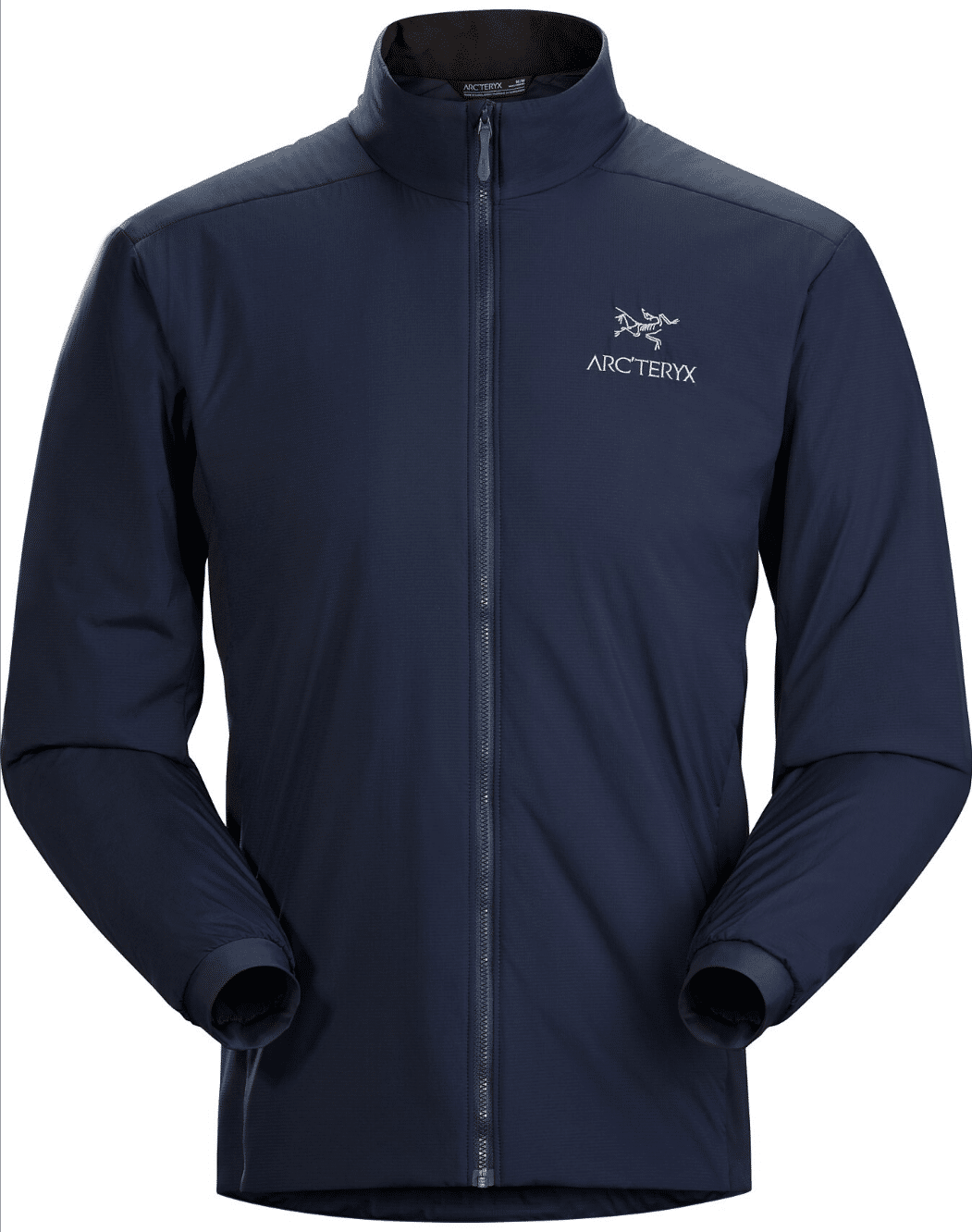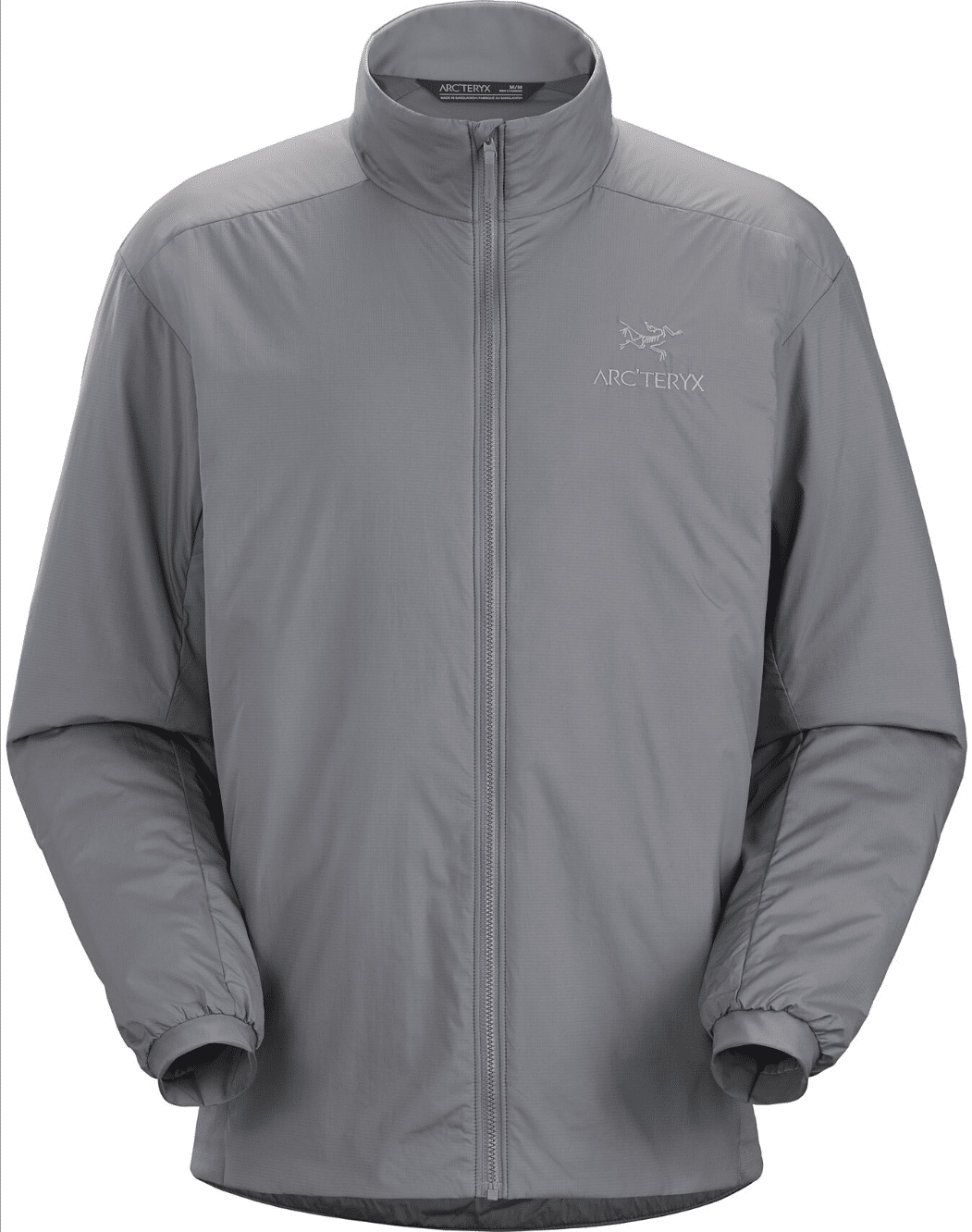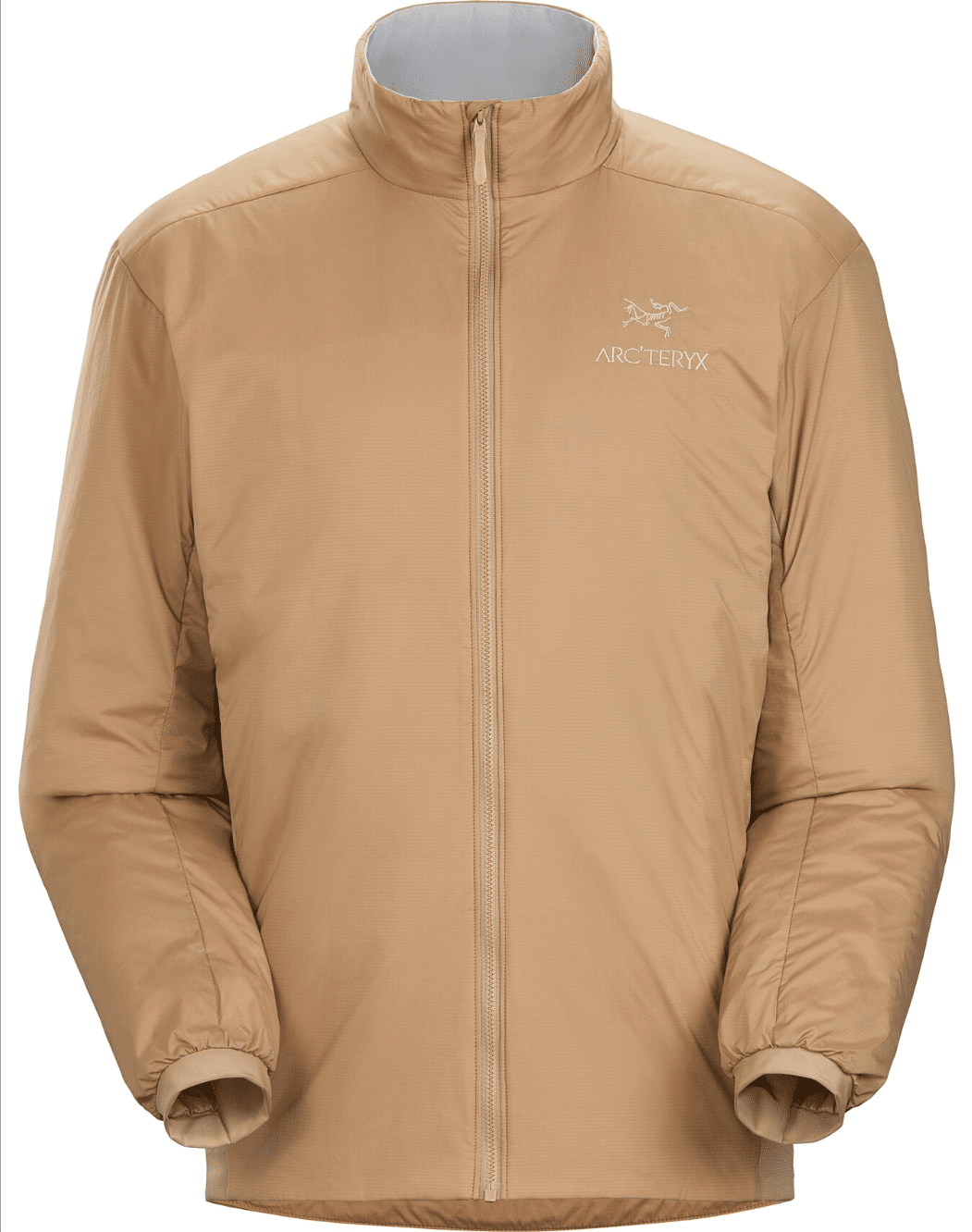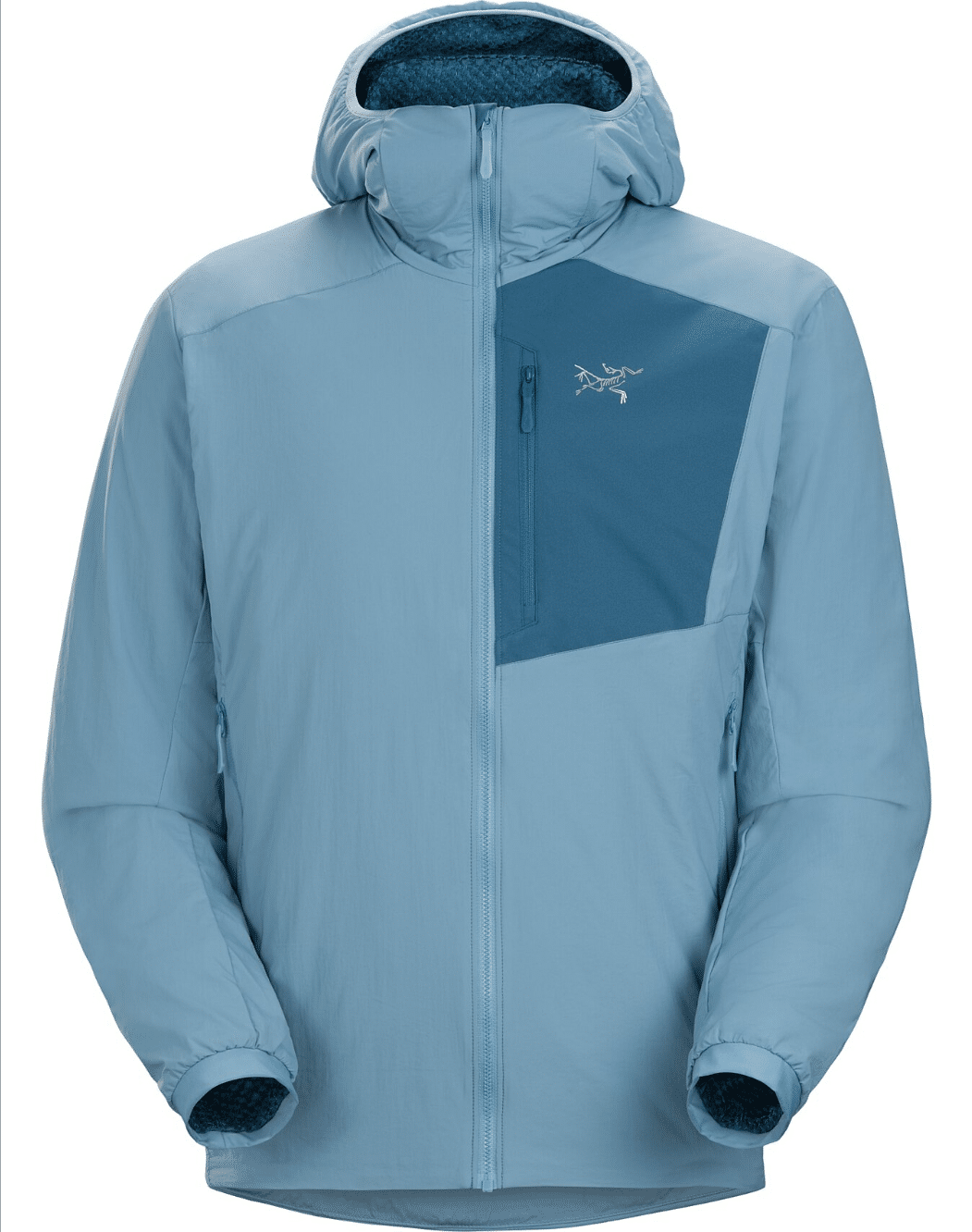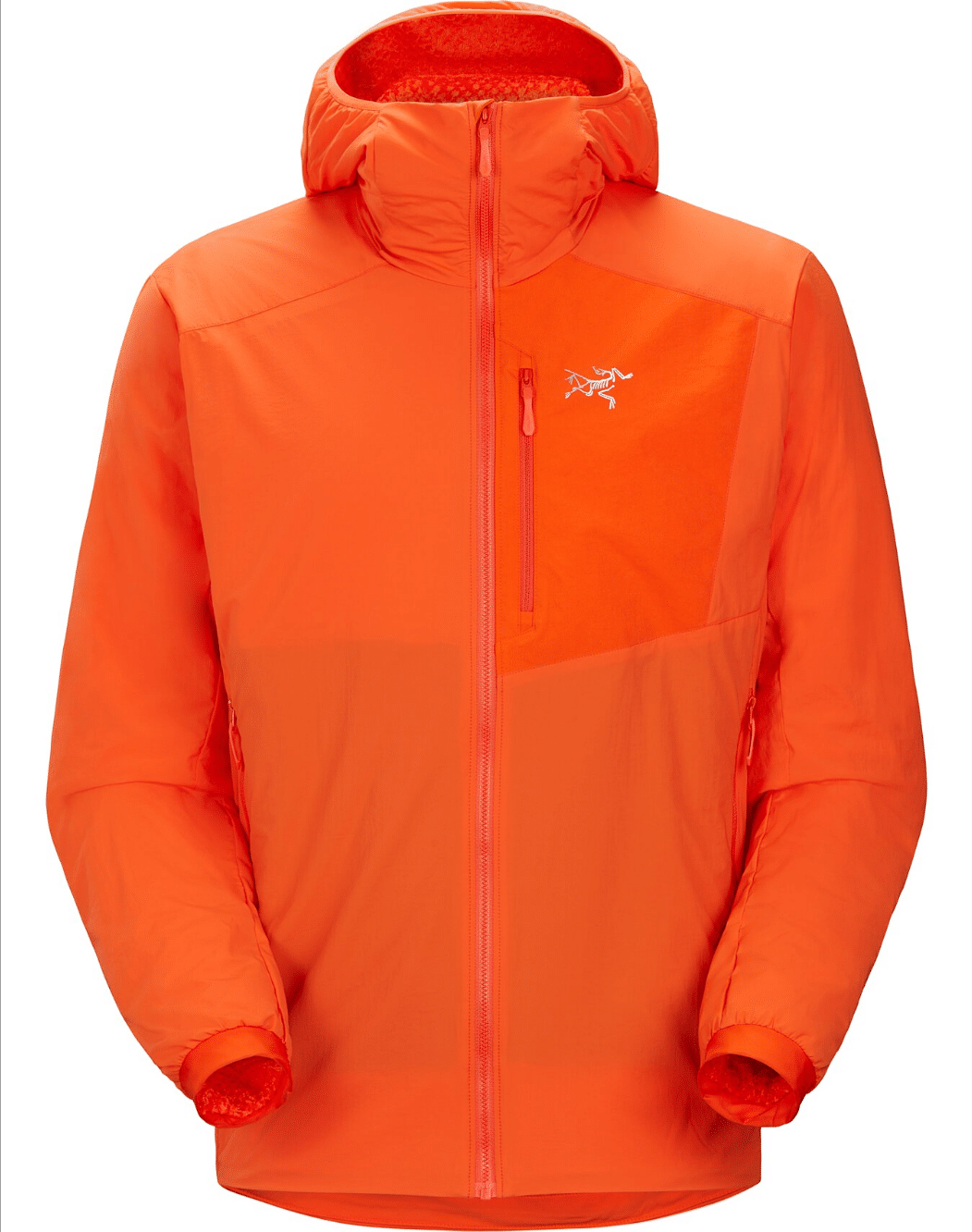
The available lineup of men's Arc'teryx Proton and Atom jackets varies throughout the year depending on season. It can include the Proton Hybrid Hoody, Proton Hoody, Proton Heavyweight Hoody, Atom Heavyweight Hoody, Atom Hoody, and Atom SL. The revised Proton SL Hoody (formerly the Proton Lightweight) is also available for spring 2025.
Arc'teryx Atom vs Proton: Overview

We've owned every model of Atom and Proton from recent years, including the Proton Hybrid, Proton SL Hoody (formerly Proton Lightweight), Proton, Proton Heavyweight, Atom SL, Atom, and Atom Heavyweight.
- Proton Heavyweight vs Atom Heavyweight (aka Atom AR): Both are great options for cold weather. But if I had to choose one, I'd go with the Proton Heavyweight (breathes better, has more pockets, and is more abrasion resistant). I also happen to think it's more comfortable. If, however, I wanted to maximize warmth and wind resistance at all costs, I'd go with the Atom Heavyweight.
- Proton vs Atom (aka Atom LT): They're very similar jackets and excellent choices for both medium- to high-output activities and casual use. The Proton offers a bit more abrasion resistance; the Atom offers a bit more breathability.
- Here's how Arc'teryx compares the Proton Hoody vs Atom Hoody
- Proton SL Hoody (formerly Proton Lightweight) vs Atom SL Hoody: Ideal for high-output activities and casual use during cool weather. The Proton SL Hoody (spring 2025 version was released in March) offers a bit more abrasion resistance and has one more pocket. Importantly, it's also insulated throughout the entire jacket, including the hood. The Atom SL is more of a niche jacket, with light insulation only in the body. The sleeves and hood aren't insulated and function more like a windbreaker. If you are interested in an SL jacket, you should also check out our in-depth review of the Patagonia Nano-Air Ultralight.
- Here's how Arc'teryx compares the Proton SL vs Atom SL
Arc'teryx Atom vs Proton: Summary

I love the Proton SL (formerly Proton Lightweight). Terrific fit and comfort. I'm 5'11", 165 pounds, athletic build, and size medium fits me perfectly. Delivers that top-notch quality feeling, too.
To choose between the current lineup of Arc'teryx Atom and Proton jackets, you should first determine the level of warmth you need. Check out our jacket temperature ratings table below.
Now you know if you need a heavyweight model, a base model, or a lightweight model. And you only have to decide between Atom and Proton.
All Atoms offer performance fleece stretch side panels for increased mobility and breathability. It doesn't work quite as well in the Atom Heavyweight, but it works perfectly with the Atom and Atom SL because those fleece side panels are much longer.
All Atoms also come with a StormHood, unlike the Protons that come with a standard hood. (https://outdoorcrunch.com/stormhood-vs-drophood/)
I personally find the Protons a bit more suitable for high-abrasion activities - think climbing, skiing and/or backpack use without a shell.
Atoms, on the other hand, are a bit more suitable for all-round use and/or if you use the hood a lot. Think a combination of a variety of high-output activities. It's perfectly fine for climbing, skiing and/or heavy backpack use as well, just not quite as abrasion-resistant as the Protons.
The differences between the same line (heavyweight, base, lightweight) Atom vs Proton might not be that noticeable to you in practice. So if you care about the looks of your jackets as much as their performance, I don't see anything wrong in going after the model you think looks best - especially if you're planning to wear your jacket casually around town.
In other words, as long as you get the weight right (heavyweight vs base vs lightweight variants), whether you go with an Atom or a Proton model shouldn't matter a ton.
You might also want to check out Arc'teryx's Naming Scheme page, which describes both the Atom and Proton lines.
The Proton Hybrid Hoody (Men's - Women's - read review) is different enough from the other models that I don't think it belongs in an Atom vs Proton comparison, so I won't mention it here.
Naming changes
Arcy'teryx seems to tweak the names of their products almost as often as they release and revise them. It can be difficult to keep it straight from season to season. For those of you longtime Arc'teryx fans, here's a quick overview of the recent name changes to the Atom and Proton lines. The name to the right of the arrow represents the current product name.
- Atom AR → Atom Heavyweight
- Atom LT → Atom
- Atom SL
- Proton LT → Proton Hoody
- Proton FL → Proton Lightweight → Proton SL Hoody
- Proton Heavyweight Hoody
- Proton Hybrid Hoody
In most cases, the changes are exclusive to the naming and fit. Each jacket's general design and materials remain largely the same.
Performance data axis of synthetic jackets (table above) and shell jackets (this table) are different. Don't compare them.
Name Activity Temp (F/C) Breathability Weather Res. Durability Bottom line Review Pit zips? Two way zipper? Stuffs into itself? Face Fabric Fit Weight Length Alpha (aka AR) (Men's - Women's) Climbing N/A 8/10 9/10 8/10 4/10 Go-to climbing harshell. Review Yes No No N40d & N80d Most Rugged 3L Gore-Tex Pro Regular 430 g / 15.2 oz 79.5 cm / 31.25 in No Alpha SV (Men's - Women's) Climbing N/A 8/10 10/10 10/10 3/10 Strongest climbing hardshell. Review Yes No No N100d Most Rugged 3L Gore-Tex Pro Regular 510 g / 1 lb 2 oz 78 cm / 30.75 in No Beta (Men's - Women's) All Round N/A 6/10 7/10 7/10 8/10 Streamlined all-doer shell. Review No No No N30p-X 3L Gore-Tex Trim 300 g / 10.6 oz 76 cm / 30 in No Beta AR (Men's - Women's) All Round N/A 8/10 9/10 9/10 4/10 Go-to all-round harshell. Review Yes No No N40d & N80d Most Rugged 3L Gore-Tex Pro Regular 460 g / 1 lb 76 cm / 30 in No Beta AR StormHood (Men's - Women's) All Round N/A 8/10 9/10 9/10 4/10 Review Yes No No N40d & N80d Most Rugged 3L Gore-Tex Pro Regular 460 g / 1 lb 76 cm / 30 in No Beta Coat (Women's) All Round N/A 6/10 5/10 No data 5/10 No Yes No 3L Gore-Tex Regular 320 g / 11.3 oz 88 cm / 34.5 in No Beta Down Insulated (Men's) All Round 0/-18 9/10 7/10 8/10 No data Yes Yes No 2L 40D Gore-Tex Regular 760 g / 1 lb 10.8 oz 79 cm / 31 in No Beta Insulated (Men's - Women's) All Round 21/-6 9/10 7/10 8/10 No data Go-to hybrid jacket. Review Yes Yes No N40d 2L Gore-Tex Regular 680 g / 1 lb 8 oz 78.5 cm / 31 in No Beta Insulated Coat (Women's) All Round 16/-9 7/10 No data No data No data No Yes No N40d 2L Gore-Tex Regular 600 g / 1 lb 5.2 oz 86 cm / 34 in No Beta Lightweight (Men's - Women's) All Round N/A 8/10 7/10 7/10 6/10 Review Yes No No N40p 3L Gore-Tex Fitted 380 g / 13.4 oz 75 cm / 29.5 in No Beta LT (Men's - Women's) All Round N/A 7/10 7/10 8/10 6/10 Review Yes No No N40d 3L Gore-Tex Fitted 395 g / 13.9 oz 76 cm / 30 in No Gamma (aka LT) (Men's - Women's) All Round N/A 7/10 3/10 7/10 3/10 Go-to softshell. Review No No No Wee Burly Double Weave Regular 545 g / 1 lb 3.2 oz 76 cm / 30 in No Gamma MX (Men's) All Round N/A 6/10 4/10 8/10 3/10 Strongest softshell. Review No No No Fortius 2.0 Regular 555 g / 1 lb 3.6 oz 74 cm / 29.1 in No Norvan Shell (Men's) Running N/A No data No data No data No data No No No 13D 3L Gore-Tex Trim 190 g / 6.7 oz 73 cm / 28.75 in No Rush (Women's) Skiing N/A 8/10 9/10 9/10 3/10 Go-to ski jacket. Review Yes No No N80p-X & N100p-X 3L Most Rugged Gore-Tex Pro Regular 590 g / 1 lb 4.8 oz 79.5 cm / 31.25 in No Rush Insulated (Women's) Skiing 16/-9 3/10 5/10 5/10 9/10 Review No No Yes Hadron 2L Gore-Tex Infinium Regular 515 g / 1 lb 2.2 oz 79 cm / 31 in Yes Sabre (Men's) Skiing N/A 8/10 8/10 7/10 2/10 Review Yes No No N80p-X 3L Gore-Tex Regular 705 g / 1 lb 8.9 oz 79 cm / 31 in No Sentinel (Women's) Skiing N/A 8/10 7/10 7/10 2/10 Go-to ski jacket. Review Yes No No N70p 3L Gore-Tex Regular 640 g / 1 lb 6.6 oz 73.7 cm / 29 in No Sentinel Insulated (Women's) Skiing 21/-6 8/10 No data No data No data Review Yes No No N80p 2L Gore-Tex Regular 600 g / 1 lb 5.2 oz 79.8 cm / 31.5 in No Sentinel Relaxed (Women's) Skiing N/A No data No data No data No data Yes No No N80p 3L Gore-Tex Regular 655 g / 1 lb 7.1 oz ? No Sidewinder (Women's) Skiing N/A 8/10 8/10 7/10 2/10 Yes No No N80p 3L Gore-Tex Regular 570 g / 1 lb 4.1 oz ? No Solano (Men's - Women's) Around Town N/A No data No data No data No data Review No No No Gore-Tex Infinium Relaxed 355 g / 12.5 oz 72 cm / 28.3 in No Squamish (Men's - Women's) Running N/A 5/10 4/10 7/10 9/10 Go-to running jacket. Review No No Yes 30D Tyono Trim 140 g / 4.9 oz 77.5 cm / 30.5 in No Theriss Down (Women's) Skiing No data 7/10 6/10 7/10 2/10 Review Yes No No N80p 2L Gore-Tex Regular 709 g / 1 lb 9 oz 63 cm / 24.8 in No Alpha FL (Men's - Women's) Climbing N/A 7/10 No data No data 10/10 No No Yes Hadron 3L Gore-Tex Trim 209 g / 7.4 oz 76.5 cm / 30 in Yes Alpha IS (Men's) Climbing 23/-5 7/10 5/10 No data 8/10 No Yes Yes N40p-X 2L Gore-Tex Regular 610 g / 1 lb 5.5 oz 78 cm / 30.75 in Yes Alpha SL (Men's - Women's) Climbing N/A 5/10 7/10 No data 9/10 No No Yes N40p 3L Gore-Tex Trim 326 g / 11.5 oz 77.5 cm / 30.5 in Yes Beta SV (Men's - Women's) All Round N/A 8/10 10/10 10/10 3/10 Strongest all-round harshell. Review Yes No No N80p-X Most Rugged 3L Gore-Tex Pro Regular 495 g / 1 lb 1.5 oz 79 cm / 31 in Yes Gamma SL (aka lightweight) (Men's - Women's) All Round N/A 7/10 2/10 6/10 5/10 Review No No No Fortius 1.0 Trim 310 g / 10.9 oz 74 cm / 29.1 in Yes Incendia (Women's) Skiing N/A 8/10 9/10 9/10 3/10 Review Yes No No NP100d 3L Gore-Tex Trim 610 g / 1 lb 5.5 oz 79 cm / 31 in Yes Incendo (Men's) Running N/A 7/10 4/10 5/10 10/10 Review No No Yes Lumin Trim 125 g / 4.4 oz ? Yes Incendo Airshell (Men's Running N/A No data No data No data No data No No Yes ? Trim 105 g / 3.7 oz ? Yes Incendo SL (Men's) Running N/A 7/10 4/10 4/10 10/10 Review No No Yes Permair 20 & Canim Trim 80 g / 2.8 oz 73 cm / 28.75 in Yes Macai (Men's) Skiing 5/-15 7/10 7/10 6/10 1/10 Review Yes No No N40p-X 3L Gore-Tex Regular 990 g / 2 lb 2.9 oz 75 cm / 29.5 in Yes Macai Lightweight (aka LT) (Men's) Skiing 8/-13 7/10 7/10 6/10 2/10 Review Yes No No N40p-X 3L Gore-Tex Regular 855 g / 1 lb 14.2 oz ? Yes Macai Shell (Men's) Skiing N/A No data No data No data No data Review Yes No No N80p-X 3L Gore-Tex Regular 775 g / 1 lb 11.3 oz ? Yes Micon (Men's) Skiing N/A No data No data No data No data Yes No No N80p 3L Gore-Tex Regular 685 g / 1 lb 8.2 oz 83 cm / 32.5 in Yes Micon Heather Skiing N/A No data No data No data No data Yes No No NP100-d 3L Gore-Tex Regular 685 g / 1 lb 8.2 oz 83 cm / 32.5 in Yes Nodin (Men's - Women's) Running N/A 8/10 5/10 5/10 10/10 No No Yes 20D Tyono Trim 130 g / 4.6 oz 75 cm / 29.5 in Yes Norvan LT (Men's - Women's) Running N/A 5/10 5/10 8/10 6/10 No No No N13p 3L Gore-Tex Trim 190 g / 6.7 oz ? Yes Norvan SL (Men's - Women's) Running N/A 7/10 6/10 8/10 8/10 Review No No Yes Gore-Tex Infinium Trim 120 g / 4.2 oz 77 cm / 30.4 in Yes Norvan SL Ins. (Women's) Running 39/4 No data No data No data No data No No Yes Gore-Tex ShakeDry Trim 270 g / 9.5 oz 71.5 cm / 28.1 in Yes Norvan Windshell (Men's Running N/A No data No data No data No data No No Yes Permeair 20 Trim 90 g / 3.2 oz 73 cm / 28.75 in Yes Procline (Men's) Skiing N/A No data No data No data No data Yes No No N70p Gore-Tex Infinium Trim 720 g / 1 lb 9.4 oz 76 cm / 30 in Yes Ravenna (Women's) Skiing N/A 8/10 7/10 8/10 3/10 Review Yes No No N70s-4 3L Gore-Tex Trim 725 g / 1 lb 9.6 oz 69.5 cm / 27.4 in Yes Ravenna LT (Women's) Skiing N/A 6/10 6/10 6/10 5/10 Review Yes No No N70p 3L Gore-Tex Trim 540 g / 1 lb 3 oz 69 cm / 27.2 in Yes Sabre AR (Men's) Skiing N/A 7/10 8/10 7/10 7/10 Review Yes No No N70p 3L Gore-Tex Regular 700 g / 1 lb 8.7 oz 79 cm / 31 in Yes Sabre Insulated (See related products) Skiing No data 7/10 No data 6/10 No data Review Yes No No N80p 2L Gore-Tex Regular 815 g / 1 lb 12.7 oz 76 cm / 30 in Yes Sabre LT (Men's) Skiing N/A 7/10 8/10 7/10 8/10 Review Yes No No N80p 3L Gore-Tex Regular 660 g / 1 lb 7.3 oz 83 cm / 32.5 in Yes Sabre SV (Men's) Skiing N/A 10/10 10/10 10/10 1/10 Strongest ski jacket. Review Yes Yes No N100d Most Rugged 3L Gore-Tex Pro Regular 595 g / 1 lb 5 oz 85 cm / 33.5 in No Sentinel AR (Women's) Skiing N/A 7/10 8/10 7/10 7/10 Review Yes No No N70p 3L Gore-Tex Regular 590 g / 1 lb 4.8 oz 72.5 cm / 28.5 in Yes Sentinel LT (Women's) Skiing N/A 7/10 8/10 7/10 8/10 Review Yes No No N80p 3L Gore-Tex Regular 565 g / 1 lb 3.9 oz 73.5 cm / 29 in Yes Shashka Stretch (Women's) Skiing N/A No data No data No data No data Yes No No N70p Gore-Tex Infinium Trim 670 g / 1 lb 7.6 oz 71 cm / 28 in Yes Trino SL (Men's) Running N/A 8/10 5/10 7/10 6/10 Review No No No Gore-Tex Infinium Trim 340 g / 12 oz 74 cm / 29.1 in Yes Trino SL Anorak (Women's) Running N/A 8/10 7/10 8/10 7/10 Review No No No Gore-Tex Infinium Trim 290 g / 10.2 oz 65 cm / 25.5 in Yes Venda Anorak (Women's) Around Town N/A No data No data No data No data No No No Gore-Tex Relaxed 255 g / 9 oz 75.5 cm / 29.7 in Yes Zeta AR (Men's) Hiking N/A 7/10 8/10 7/10 4/10 Yes No No 3L Gore-Tex Regular 425 g / 15 oz 80 cm / 31.5 in Yes Zeta FL (Men's - Women's) Hiking N/A 4/10 6/10 4/10 6/10 No No No N20r 2L Gore-Tex Trim 221 g / 7.8 oz 76 cm / 30 in Yes Zeta LT (Men's - Women's) Hiking N/A 5/10 7/10 8/10 5/10 No No No N40P-X 3L Gore-Tex Trim 335 g / 11.8 oz 78 cm / 30.75 in Yes Zeta SL (Men's - Women's) Hiking N/A 3/10 5/10 4/10 5/10 Review No No No 2L Gore-Tex Trim 310 g / 10.9 oz 77.8 cm / 30.6 in Yes
Arc'teryx Atom Heavyweight vs Proton Heavyweight
The Atom Heavyweight (formerly Atom AR) is a flagship Arc'teryx product. It's been around for more than 10 years and is a proven performer. It's long been a top recommendation of mine.
The Proton Heavyweight, on the other hand, was released for the first time in fall/winter 2023. I fell in love with it the first time I saw it.
Overview
The Atom Heavyweight is more wind resistant and a bit warmer. It also offers the StormHood. The Atom Heavyweight has mesh paneling at the armpits for increased breathability, but I don't think they make much of a difference in practice. The Proton Heavyweight, on the other hand, is more breathable even though it doesn't offer any mechanical venting. It's also more durable, a bit more water resistant and offers three more pockets than the Atom Heavyweight.
Warmth
The Atom Heavyweight is warmer by a small margin.
- Atom Heavyweight:
- 120 g/m2 of Coreloft in the body
- 80 g/m2 of Coreloft in the sleeves
- 60 g/m2 of Coreloft in the hood
- Proton Heavyweight:
- 100 g/m2 of Coreloft in the body
- 60 g/m2 of Coreloft in the sleeves and hood
But this can be a double-edged sword because of the Atom Heavyweight's face fabric, which is 30 denier Tyono. I'll explain below.
Breathability
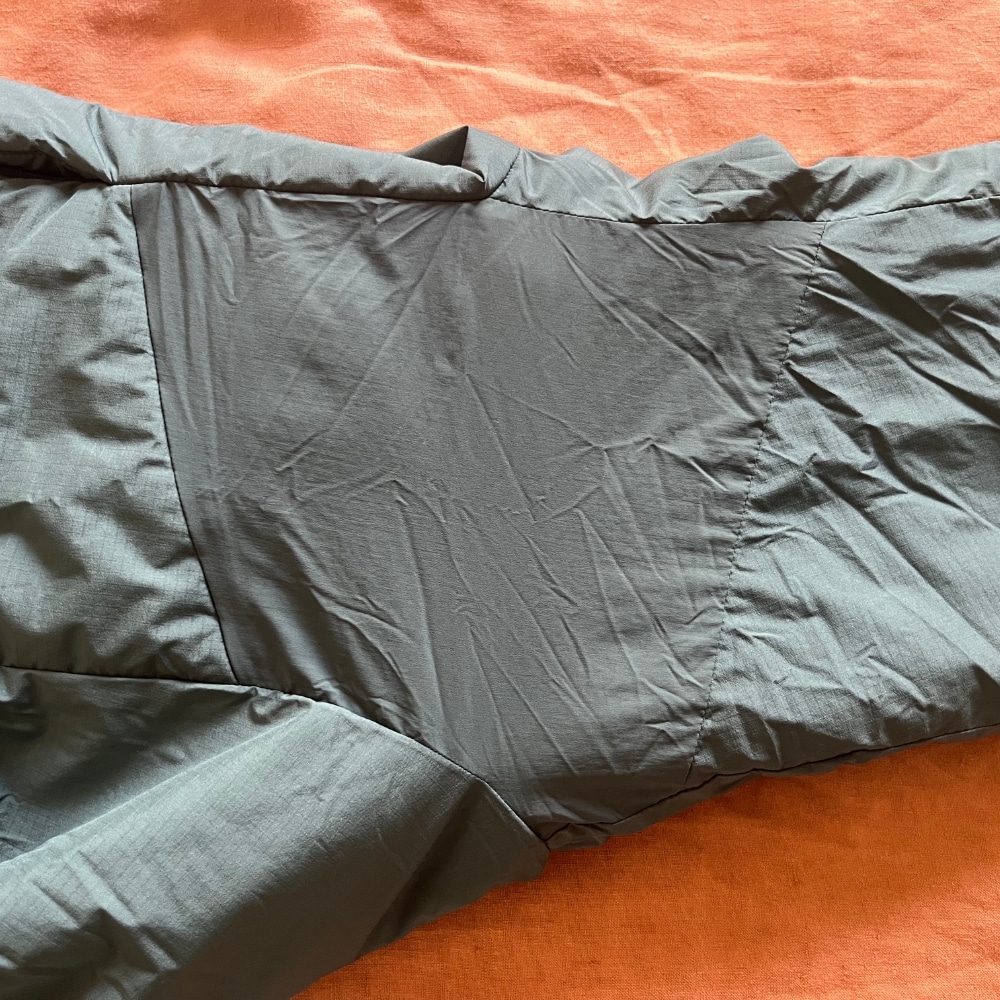
Atom Heavyweight. Mesh panels at the armpits.
Tyono is nylon. It offers poor breathability. That's why Arc'teryx incorporates much larger fleece side panels into its other Atom models. The Atom Heavyweight's lone fleece paneling is in the armpits, which is just too small to make a significant difference.
All of this is to say that it's entirely possible to overheat in the Atom Heavyweight. I wish it offered a two-way zipper, which I use a lot with my Nuclei SV.
The Proton Heavyweight, conversely, is noticeably more breathable even without any mechanical venting options. That's because its face fabric of Fortius Air 50 allows air permeability much more than the 30d Tyono of the Atom Heavyweight.
You might also want to pay attention to the possible color differences occur at this area. I've grabbed mine in Boxcar, so it doesn't have any color differences as you see in the image. But some models like the Gold colorway do.
Hood

Drawcords in Atom Hw.
The Atom Heavyweight offers StormHood, whereas the Proton Heavyweight's hood is just the standard variety. Additionally, the Atom offers inner drawcords to tighten and cinch the hood as you like.
Pockets
The Proton Heavyweight absolutely destroys the Atom Heavyweight in this department.
The Atom provides two hand warmers with hidden zippers and one internal chest zippered pocket. The chest pocket is mid- to small-sized. I can fit my iPhone easily in there.
The Proton Heavyweight, on the other hand, offers two hand warmers, two external zippered chest pockets (one on each side), and two internal dump pockets. Dump pockets never add to the weight of the jacket either (no zips). So it comes almost at no extra energy cost, which is great.

Proton Heavyweight chest pocket dimensions. Unlike Proton Lw (aka FL) and Proton (aka LT), the pocket spans beyond the colored chest area, as you see in the image.
That makes three more pockets on the Proton - or in other words, double the number of pockets as the Atom Heavyweight.
Pocket dimensions are as follows:
- Atom Heavyweight:
- Hand warmers: 6.7 in (or 17 cm) x 9.4 in (or 24 cm)
- Internal zippered chest pocket: 7.5 in (or 19 cm) x 10.6 in (or 27 cm)
- Proton Heavyweight:
- Hand warmers: 9.1 in (or 23 cm) x 8.3 in (or 21 cm)
- Internal dump pockets: 7.9 in (or 20 cm) x 8.3 in (or 21 cm)
- External chest pockets: See image.
I love more pockets. Did you see this Arc'teryx fan by the way? Hilarious.
Durability
Proton Heavyweight has the edge in durability.
The difference between Proton Hw and Proton (aka LT) is bigger than the difference between Atom Hw and Atom (aka LT) in this regard.
Proton Hw has a burly face fabric. It's not unusual for a 50D face fabric to outshine a 30D in this regard.
Weather resistance
Both are fairly weather resistant. But the Atom Heavyweight has the edge over the Proton Heavyweight.
All Atoms feature that previously mentioned Tyono outer face fabric, which is effectively wind resistant. The standard Atom jacket as well as the Atom SL, on the other hand, have those side fleece panels that let wind through, particularly if your arms aren't at your sides. This is one area where the fleece panels in the Atom Heavyweight's armpits help by minimizing wind permeation.
Both the Atom Heavyweight and Proton Heavyweight have DWR (durable weather resistance) coatings, which means their outer fabric is water resistant but certainly not waterproof.
DWR is a coating. It's basically sprayed on to the surface of these jackets as a finish. It stands for Durable Water Repellent - which means that water will be repelled under wet conditions instead of soaking into the fabric. DWR also decreases dry time. It's a good thing these jackets are coated in DWR. But pay attention to the fact that DWR is a coating - meaning that it will wear off over time. Which is why you might want to invest in a DWR spray such as this one at arcteryx.com for after treatment. As you see, there's a strong correlation between FP x FW and temperature ratings, but not more than, say, 80%. I explained why this happens here in this post of mine.
Cuffs
Cuffs are similar on both - stretch knit.

Atom Heavyweight (aka AR) on the left and Proton Heavyweight on the right.
Sleeve length is the same.
Fit
Both come in Arc'teryx's revised fit.
Canberk is 5'11" and 165 pounds, with an athletic build. Size Medium fits him perfectly across almost all brands and product lines. 
Arc'teryx Atom (aka Atom LT) vs Proton (aka Proton LT): Overview
These two are the most popular models in each line. I'd recommend you base your decision when it comes to Proton vs Atom primarily on what you're planning to do with the jacket, your preference when it comes to side fleece panels, and finally, your taste when it comes to looks.
Because of superior warmth and abrasion resistance of the Proton, I think it's the better pick for climbing and skiing.
The Atom, on the other hand, is the better choice if you tend to run warm, love side fleece panels for increased breathability, or will use the hood a lot.
Warmth
Both Atom and Proton use Coreloft Compact. But the Proton is equipped with 80 gsm of it in the body and 60 gsm in the hood, whereas the Atom is equipped with 60 gsm everywhere.
On top of that, side fleece panels of Atom make a great job in terms of increasing breathability, but in return, this also causes the heat to escape.
Proton also comes with slightly longer hem (center back) length, which makes another noticeable difference in warmth.
Weather Resistance & Durability

Side fleece panels of Atom (aka LT).
The face fabric of Proton (Fortius Air 20) is designed to balance air permeability and weather protection. It's especially convenient where wind and water resistances are required without sacrificing too much breathability. This makes it suitable for active use.
The design of the face fabric of Atom (Tyono 20) is more directed towards compressibility and weight savings. It's fairly breathable but its main objective is wind resistance.
This is why you'll see Atoms being used as wind jackets. They're spectacularly good at this. Atom SL (soon to be called Lw) isn't even insulated in the arms, for example, unlike its corresponding Proton, the Proton Lw (aka FL). It feels like you're wearing an insulated vest + a windbreaker on top of it.
One thing that is worth noting in here is that Atom offers side fleece panels, which can (will) let the wind in and warmth out when your hands are up.
As you see, it isn't possible to make definitive judgements about the weather resistances of these two. Proton is definitely a bit more durable and very slightly more water resistant. But when it comes to wind resistance, I think it depends on the person and the intended use.
Overall, I'd say Proton is a bit more weather resistant. But nothing noticeable.
Also, both jackets are DWR applied.
DWR is a coating.
It's basically sprayed on to the surface of these jackets as a finish.
It stands for Durable Water Repellent - which means that water will be repelled under wet conditions instead of soaking into the fabric.
DWR also decreases dry time.
It's a good thing these jackets are coated in DWR.
But pay attention to the fact that DWR is a coating - meaning that it will wear off over time.
Which is why you might want to invest in a DWR spray such as this one at arcteryx.com for after treatment.
As you see, there's a strong correlation between FP x FW and temperature ratings, but not more than, say, 80%. I explained why this happens here in this post of mine.
Breathability
Had all the other factors been equal (they're not), then Fortius Air 20 of Proton would make it more breathable than the 20D Tyono of Atom - as I explained earlier. Comparing pure membranes in here, back to back.
But even though technology has gone a long way in terms of engineering more breathable and durable fabric (like Fortius Air), mechanical venting still tops it. Ultimately, the side fleece panels of the Atom, which span from the armpits to the hem on both sides, make it more breathable than the Proton.
Side fleece panels of Atom are pretty popular.
Mobility & Comfort

Chest pocket dimensions of Proton (aka LT).
Elastane is what gives jackets the stretchy nature. Fortius Air 20 of Proton involves 16% elastane, where 20D Tyono of Atom involves %6 of it.
Atom, however, has stretchy panels in the armpits, which gives the arms and shoulder more mobility.
A quick recap here, a design that allows more stretching also increases durability.
Stitches experience less stress with it and hence the jackets last more.
I feel better in Proton, but that's because the outer fabric is smoother. It's more fun to wear for me.
In terms of mobility and comfort, I think it's a draw.
Pockets
Unlike other two comparisons (Atom Hw vs Proton Hw & Atom SL vs Proton Lw), this is the only comparison where Proton does not outshine Atom.
In addition to two hand warmers both jackets offer, Atom offers an additional internal zippered chest pocket, and Proton offers an additional external zippered chest pocket.
Below are the pocket dimensions.
- Atom:
- Hand warmers: 10.6 in (or 27 cm) height x 7.1 in (or 18 cm) width
- Internal zippered chest pocket: 9.9 in (or 25 cm) height x 7.5 in (or 19 cm) width
- Proton:
- Hand warmers: 9.4 in (or 24 cm) height x 7.5 in (or 19 cm) width
They're pretty much comparable.
Packability
Neither of these jackets have a pocket that they can stuff into. Wish they did.
Fit
Both come in revised fit.
Canberk is 5'11" and 165 pounds, with an athletic build. Size Medium fits him perfectly across almost all brands and product lines.

Cuffs
Their cuffs are similar.

Atom (aka LT) on the left and Proton (aka LT) on the right.
Sleeve length is the same.
Historical Revisions
FW24: Atom LT and Proton LT changed to Atom and Proton
Arc'teryx removed the LT from both products in FW24. They became simply the Proton and Atom. Changes have been exclusive to the naming and fit. Structural designs remain the same.
FW20: Atom LT revision
Not much has changed really.
With the 2020 revision, the Atom was given a dope-dyed liner, a new construction on the cuff and was made 1 inch (2.5 cm) longer.
As a result:
- Cuff construction allows for easier on/off and layering
- Durability is slightly increased now owing to dope-dyed liner (Dope Permeair™ 20 - 100% nylon) - but the difference is really not very noticeable.
Additionally, Dope Dying is much more environmentally friendly, so Arc'teryx is also reducing its mark on the planet by incorporating it into the production process.
Transcript of my chat with the customer service
- Hi there! My name is Camille, how can I help you today?
- Hi Camille. I was wondering about the updates that took place for the 2020 revision of Atom LT. Can you list all the changes, please?
- Hi there, thanks for chatting. I sure can.
- The redesign includes an update to the cuff construction for easier on/off and layering, an updated material package for enhanced durability, updated fit, and a dope dyed liner.
- What do you mean by updated material package?
- We updated the materials the Atom LT is made of, you can read a list of them here:
- Coreloft™ Compact (60 g/m² ) insulation. Highly crimped, multi-denier siliconized polyester yarn that has undergone a special process which reduces the thickness of the material by 50%, without reducing its insulation value by the same amount. Lightweight, breathable, thermally efficient 100% polyester fibre.
Tyono™ 20 denier shell with DWR treatment - 100% nylon
Stretch fleece - 94% polyester, 6% elastane
Dope Permeair™ 20 - 100% nylon - Last year's model did not include the Dope Permeair.
- How does it affect the use of this jacket in practice?
- It doesn't effect it, really - Dope Dying is much more environmentally friendly so we are reducing our mark on the planet by incorporating it into the production process.
- Overall the updated Atom saw more changes with the fit, durability and construction on the cuff.
- If anything it's very slightly more durable now.
- Which update made it more durable?
- The additional dope dyed liner.
- Ok, thanks. Lastly, how did the fit change?
- It is about 1" longer than the previous year's model.
- So other than this hem length difference, everything stays the same in the fit department?
- That's right.
FW19: Proton LT revision
Fortius 40 vs 20
In order to increase breathability, designers decided to change the insulation material from Fortius 40 to Fortius 20. In English: Fabric is now slightly thinner but also more air-permeable.
This is measured with a metric called CFM (cubic feet per minute). The new Proton LT has a CFM of 40 compared to the CFM of 20 that belongs to the older version.
Coreloft Continuous vs Compact
Because the Coreloft Compact of the revised (new) version is composed of highly crimped fibers, it's more compressible and air-permeable compared to the Coreloft Continuous of the previous version.
The Coreloft Continous, on the other hand, has more fluff at the beginning (so slightly higher CLO value - which means slightly warmer) but can pack down over time meaning that the jacket will eventually lose some of its fluff and warmth a little bit.
We can say that the warmth didn't really change noticeably (if at all).
Continuous is also more durable since it's less air-permeable.
Since the design intent of Proton LT is a highly air-permeable jacket for high output activity, design team decided to switch to Coreloft Compact for air-permeability and packability reasons.
Compared to the previous model, the most recent (2019) version of Proton LT is;
- lighter,
- more packable,
- more breathable,
- slightly less durable.
Fit remains the same.
Arc'teryx Atom SL (soon to be called Lightweight) vs Proton Lightweight (aka FL): Overview
I wear an Atom SL for mid- and high-output activities, and a Proton Lightweight for everything else.
So, if you'll be performing high-output activities more than, say, 50% of the time, then the Atom SL might be a better option. It's lighter and more breathable. It also has StormHood. The Proton Lightweight doesn't.
Otherwise I'd recommend the Proton Lightweight. I love its Octa Loft. It's insanely smooth against the skin. I love wearing it. Plus you have more storage options. Handwarmer pockets are 50% larger than those on the Atom SL and you get an additional external zippered chest pocket. To me, the hood is also more comfortable when it's not on.
Warmth
Both are lightly insulated and their warmth are comparable.
The Atom SL isn't insulated around the sleeves, only around the torso. This makes it feel like you're wearing a vest and a windbreaker.
The Proton Lightweight is insulated everywhere. Unlike the synthetic insulator Coreloft used in all the other jackets in this roundup, Octa Loft is a knitted insulation, like PolarTec. Check out the images below to see what it's like.

Octa Loft of Proton Lw takes place everywhere (including the inner hood surface). The only place it's missing is the collar. This prevents itching and makes the jacket more comfortable when the collar is up. I love details like this. Really makes a difference in practice too.
Proton Lightweight is the only Arc'teryx jacket insulated with Octa Loft. It's light and unbelievably comfortable. It enhances mobility and the "stretchy" feeling of the jacket, too.
Breathability
The side fleece panels of the Atom SL make a noticeable difference. I love how much it breathes.

The side fleece panels of Atom SL span all the way from the tip of the sleeves to the hem. It's like silk road, man. I love the feeling of this jacket breathing when the arms are up. Together with the StormHood, this is one of the biggest factors that make Atom SL superior in high output activities.
But the breathability of the Proton Lightweight is also top notch, although a bit behind the Atom SL.
In previous versions of the Proton Lightweight (i.e. Proton FL), the insulation was not exposed and hence was not in contact with the skin. Now that it's exposed, it picks up moisture a bit less, allowing the jacket to breath even more.
Hood
If I'm going to be active with the hood, there's no way I'm putting on a Proton Lightweight over an Atom SL. The Atom SL offers a StormHood. When the hood is in use, Proton Lightweight's standard hood falls behind. I'd pick Atom SL over Proton every day.
Weather resistance
They're very comparable. But I feel like the Proton Lightweight holds up better to the wind.
Both are DWR coated to shed minimal amounts of precipitation.
DWR is a coating.
It's basically sprayed on to the surface of these jackets as a finish.
It stands for Durable Water Repellent - which means that water will be repelled under wet conditions instead of soaking into the fabric.
DWR also decreases dry time.
It's a good thing these jackets are coated in DWR.
But pay attention to the fact that DWR is a coating - meaning that it will wear off over time.
Which is why you might want to invest in a DWR spray such as this one at arcteryx.com for after treatment.
As you see, there's a strong correlation between FP x FW and temperature ratings, but not more than, say, 80%. I explained why this happens here in this post of mine.
Pockets

Chest pocket dimensions of Proton Lw.
In addition to the handwarmer pockets in both jackets, the Proton Lightweight offers an additional external zippered chest pocket. The colored section you see on the chest makes up the exact borders of this pocket. It's pretty large.
This adds to the weight a bit.
But an additional external pocket isn't the only advantage you get with Proton Lightweight in this regard. Its handwarmer pockets are also larger than those of the Atom SL.
- Proton Lightweight handwarmer pockets dimensions: 10.26 inches (or 26 cm) height x 7.1 inches (18 cm) width
- Atom SL handwarmer pockets dimensions: 6.1 inches (or 15.5 cm) height x 8.1 inches (or 20.5 cm) width
In other words, each handwarmer pocket of the Proton Lightweight is around 50% larger (73 square inches vs 49 square inches).
Weight
Both jackets are super light (12 oz vs 9.5 oz), but the Atom SL is lighter.
Packability
I don't understand why Arc'teryx doesn't make a stuff sack for these. Their down jackets always get one.
Patagonia always offers a stuff sack for its Nano Puff and Micro Puff jackets as well. They're kind of their Atom and Proton (light synthetic jackets).
Not packing the Heavyweight or even the base models can be understandable. But the superlight models? Not so much. I'm pretty mad about this.
Sleeves and cuffs
Sleeve lengths are the same at 25.6 inches (or 65 cm) for size medium.

Atom SL on the left and Proton Lw on the right.
Fit
Proton Lightweight comes with a revised fit. Atom SL offers legacy fit.
Canberk is 5'11" and 165 pounds, with an athletic build. Size Medium fits him perfectly across almost all brands and product lines.

Historical versions of Proton Lw
The previous Proton Lightweigeht, e.g Proton FL, was a bit different than the new model. The hood wasn't insulated, and the insulation throughout the garment was not exposed. Instead, it was the mesh in contact with the skin. Previous model also offered an extra external zippered chest pocket and came with legacy fit, obviously.
Arc'teryx Atoms vs Protons: Best colors
Join the poll or view results below.
Poll results: Best colorways of Atom Series
Upvote your favorites.

Void

Canvas

Black

Solace

Heritage

Fika/Black Sapphire

Kingfisher

Serene

Black

Canvas

Jungle Maze

Sprint

Solitude

Techno

Atmos

Sprint

Black

Orca

Solace

Fika/Spark

Black Sapphire

Expanse

Velvet Sand

Labyrinth
Quick links:

Wicker/Sprint

Solitude

Groovie

Black

Bliss/Spark

Serene

Black

Solace
Quick links:

Synth

Habitat

Moonlit

Black
Poll results: Best colorways of Proton Series
Upvote your favorites.

Lucent Multiverse

Phenom Bordeaux

Black

Serene

Black

Atmos

Sprint

Moonlit

Labyrinth

Black

Phenom
Quick links:
- Poll results: Giant Arc'teryx & Patagoina survey (Gore-Tex, pockets, hoods, fit, & more) [1000+ participated]
- Pics from outrageous discounts I ran into at Arc'teryx Parndorf Outlet
- I bought Gamma Lightweight (aka SL), Gamma (aka LT) and Gamma MX
- Patera Parka (one year update): Ain't worth the price...
- Alpha vs Beta: I bought all 4 Beta's and both Alpha's. Settling this for good
- Proton Hybrid: A "hidden" way to stuff it in itself!?
- Best Insulated Jackets: A hands-on Arc'teryx & Patagonia face-off
- 2024 Nano Air is in! Bought it immediately...
- I bought all 7 of Winter '24 Atom and Proton jackets
- Best Arc'teryx Ski Jackets: Rush is ideal, Sabre SV is overkill
- Arc’teryx colors: Most and least liked (poll results)
- Took my Nuclei SV to the Alps near Pfander, Austria
- Arc'teryx Alpha Parka Review: The most impressive jacket of all time
- Arc'teryx ReGEAR: OutdoorCrunch exclusive promo code!
- Beta Insulated Jacket is in: Pit zips AND two way zipper
- DropHood vs StormHood: Pros/cons and best uses
- 7 things all Arc'teryx newbies should know
Check out our other content on jackets:
Guide: Insulated & Shell Jackets
Start here:
Also see:





